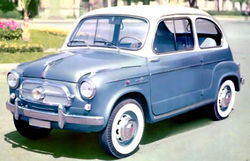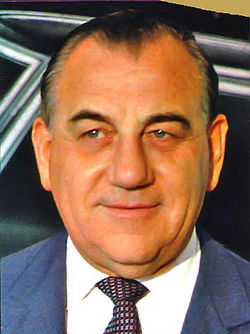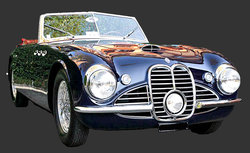Difference between revisions of "Frua"
m |
m |
||
| (2 intermediate revisions by the same user not shown) | |||
| Line 1: | Line 1: | ||
{{X}} | {{X}} | ||
[[Image:Frualogo.jpg|center|180px]] | [[Image:Frualogo.jpg|center|180px]] | ||
| − | [[Image:frua196506.jpg|thumb|right|<center>'''Pietro Frua''' (1965)</center>]] | + | [[Image:frua196506.jpg|thumb|right|250px|<center>'''Pietro Frua''' (1965)</center>]] |
| Line 15: | Line 15: | ||
In [[1957]], Frua sold his small coachbuilding company to Carrozzeria [[Ghia]] in Turin, and Ghia director [[Luigi Segre]] appointed him head of Ghia Design. In this short period, Frua was responsible for the successful [[Renault]] Floride, which experienced well-deserved commercial success. This success led to a disagreement between Segre and Frua over the car’s “paternity”, and Frua left Ghia to start his own design studio again. | In [[1957]], Frua sold his small coachbuilding company to Carrozzeria [[Ghia]] in Turin, and Ghia director [[Luigi Segre]] appointed him head of Ghia Design. In this short period, Frua was responsible for the successful [[Renault]] Floride, which experienced well-deserved commercial success. This success led to a disagreement between Segre and Frua over the car’s “paternity”, and Frua left Ghia to start his own design studio again. | ||
| − | [[File:1956 Fiat 600 elaborata Frua.jpg|thumb|rifht| | + | |
| + | [[File:1956 Fiat 600 elaborata Frua.jpg|thumb|rifht|250px|'''1956 Fiat 600 built by Frua''' [http://www.fiatfuoriserie.it<small>Source</small>] ]] | ||
At the same time, [[Pelle Petterson]] designed his [[Volvo P1800]] at Ghia under the attentive eye of Frua and, not surprisingly, it is often attributed to Frua's pen. From [[1957]] to [[1959]], Frua also designed several cars for Ghia Aigle, the former Swiss subsidiary of Ghia Turin, already independent at that time. Giovanni Michelotti was his predecessor in this position. | At the same time, [[Pelle Petterson]] designed his [[Volvo P1800]] at Ghia under the attentive eye of Frua and, not surprisingly, it is often attributed to Frua's pen. From [[1957]] to [[1959]], Frua also designed several cars for Ghia Aigle, the former Swiss subsidiary of Ghia Turin, already independent at that time. Giovanni Michelotti was his predecessor in this position. | ||
Latest revision as of 13:08, 6 July 2010
Frua
During World War II car-styling work was scarce and Pietro Frua had to turn to designing children’s cars, electric ovens and kitchen units, as well as a monocoque motorscooter.
Frua planned for post-war times: in 1944 he bought a bombed-out factory, hired 15 workers (including Sergio Coggiola, who founded his own carrozzeria in 1966) and equipped himself to design and build cars.
His first known car is a 1946 Fiat 1100 a sport Barchetta. Maserati was one of the first clients who contracted Frua for the styling of their new 2-litre, 6-cylinder sports car, the A6G. From 1950 to 1957, Frua built 19 Spyders and seven coupés in three different design series – including those on the A6 GCS racing chassis.
In 1957, Frua sold his small coachbuilding company to Carrozzeria Ghia in Turin, and Ghia director Luigi Segre appointed him head of Ghia Design. In this short period, Frua was responsible for the successful Renault Floride, which experienced well-deserved commercial success. This success led to a disagreement between Segre and Frua over the car’s “paternity”, and Frua left Ghia to start his own design studio again.

At the same time, Pelle Petterson designed his Volvo P1800 at Ghia under the attentive eye of Frua and, not surprisingly, it is often attributed to Frua's pen. From 1957 to 1959, Frua also designed several cars for Ghia Aigle, the former Swiss subsidiary of Ghia Turin, already independent at that time. Giovanni Michelotti was his predecessor in this position.
After Ghia Aigle finished coachbuilding, a former employee, Adriano Guglielmetti, started his own business and founded Carrosserie Italsuisse in Geneva. Again Pietro Frua did the drawings and, most probably, built all the prototypes for this company. After a Corvair-like styled pontoon-Beetle in 1960, Italsuisse showed a Maserati 3500 GTI Coupé on the Italsuisse stand at the 1961 Motor Show in Geneva, together with two tasteful bodies on Studebaker chassis. In 1964 a lovely little Spyder followed with Opel Kadett mechanics.
During the 1960s Pietro Frua was among the most prominent car designers in Italy. The “Frua line” was synonymous with the good taste of a single man. He followed each car’s practical realization to the last detail of the fully functional one-offs and prototypes, often driving them to their presentation at the motor shows in Europe.
In 1963, at the age of 50 and at the peak of his career, Frua designed for Glas, Germany’s smallest car-maker, the GT Coupé and Cabriolet. These were built until 1968 as the BMW GT, after BMW had bought Glas.
In the same year, Maserati showed the Frua-bodied Mistral and the four-door Quattroporte which, after several one-offs, re-established Frua’s connection with this manufacturer. With these cars Maserati was positioned into a new market of luxury and powerful, understated cars.
In 1965, AC showed the Frua-bodied, 7-litre, 428-hp AC 428 Spyder, which drew from the Mistral’s shape. A coupé followed in 1967. In the same year, Monteverdi in Switzerland started to build a Frua-bodied sport coupé, this time with a Chrysler engine.
At the end of the 1960s, Frua tried in vain to prolong his success with Glas by making a dozen proposals to BMW. BMW decided to make it on their own, but Frua’s influence can be seen even today in the “angry view” of BMWs.
In 1967 the Swiss racing driver and Ferrari importer Peter Monteverdi started to build his own sports cars, with the Frua-bodied Monteverdi 375 S. Due to Frua’s limited capacities, the production of the following models went to Fissore in Turin.
In the 1970s Frua reduced the frequency of his presentations, but in the sixth decade of his life he still demonstrated his good taste and craftsmanship to the younger ones who already had taken their role in the industrial process. There was no longer a demand to build completely detailed and functional prototypes in less than ten weeks, and no more customers for special bodied one-offs.
In 1982 Pietro Frua contracted cancer and had unsuccessful surgery in the autumn of that year. He and his long-time assistant, Gina, married shortly before he died on June 28, 1983, a few weeks after his 70th birthday.
See also
External links
- Registro Pietro Frua - The complete history and an extensive illustrated description of over 200 cars designed and built by Pietro Frua.
| Car Information and Photos by Marque: A - B - C - D - E - F - G - H - I - J - K - L - M - N - O - P - Q - R - S - T - U - V - W - X - Y - Z |
| Motorcycle Information and Photos by Marque: A - B - C - D - E - F - G - H - I - J - K - L - M - N - O - P - Q - R - S - T - U - V - W - X - Y - Z |


